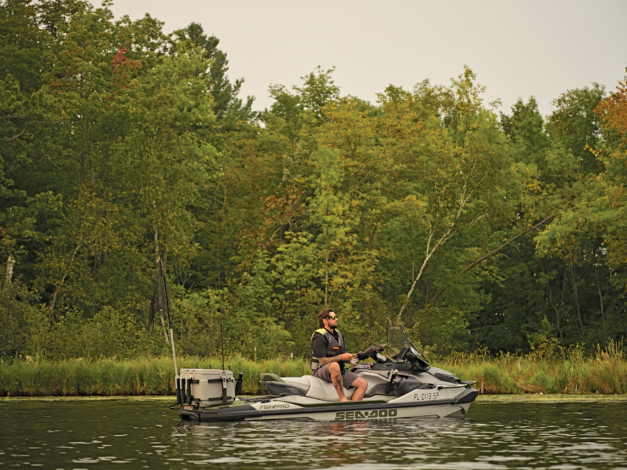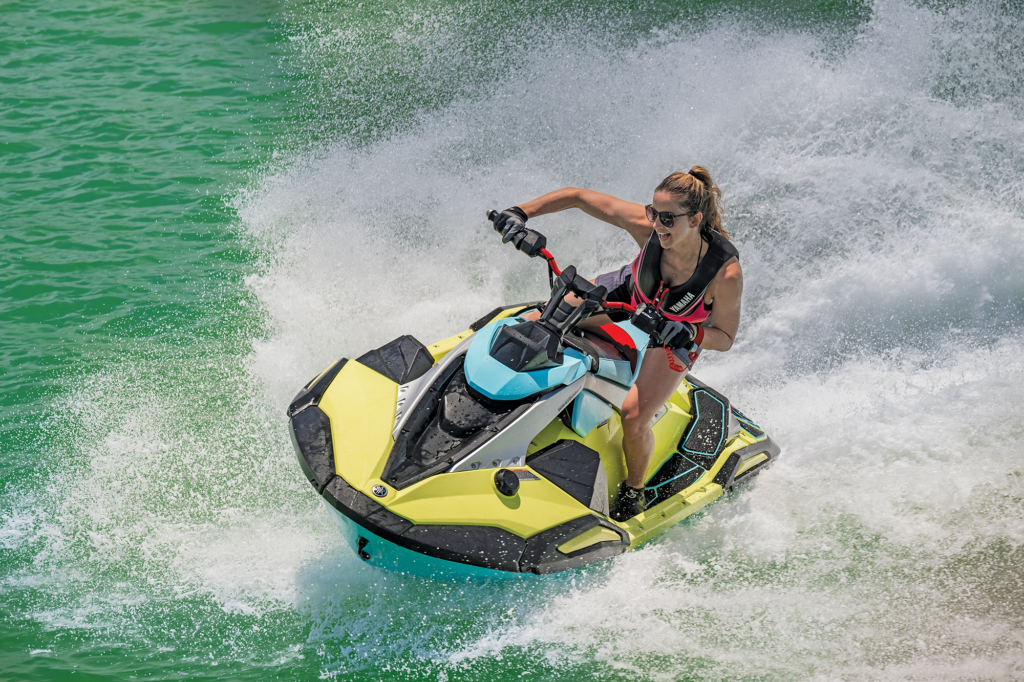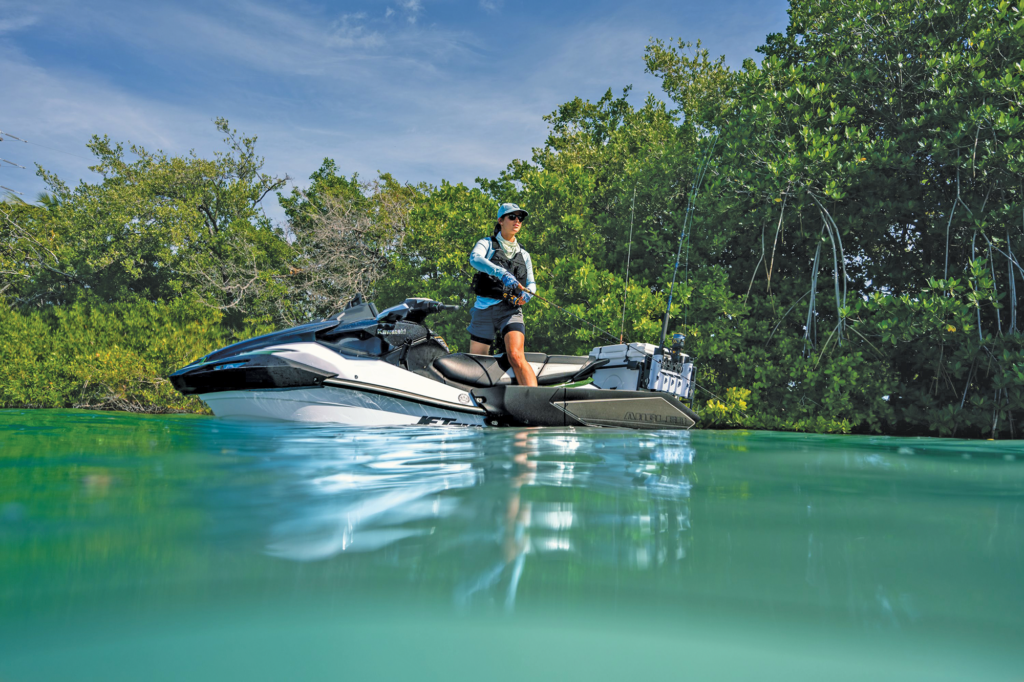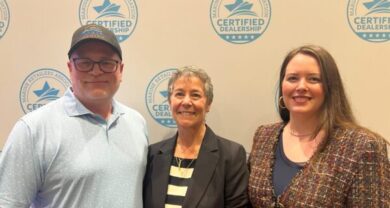Becoming one with the water

Personal watercraft manufacturers throttle forward on innovation
By Adam Quandt
Often a gateway to a lifestyle on the water, the personal watercraft segment is one to never overlook.
However, manufacturers continue to take watercraft to the next level, bringing the segment well beyond simply an entry point to boating and created a lifestyle around owning and operating PWC around the world.
While much like many other segments across the recreational boating industry, sales numbers for the PWC segment have begun to slow in the most recent data from the National Marine Manufacturers Association (NMMA) – down 15.9% compared to 2023.
However, until recently, the segment was one of the few remaining marine segments to continue climbing in sales. And despite a drop in sales, retail unit sales remain strong, with NMMA’s rolling 12-month numbers reporting over 70.5K retail units in 2024 through June.
Who’s buying?
A recent study from CDK Lightspeed focused on 71,000 new and used PWC units sold from September 2023 through August 2024.
“Roughly nine out of ten personal watercraft sold were new units,” the Lightspeed study reported. “88% were new, and 12% were used.”
In terms of where the sales are taking place, the southern region of the U.S. accounts for the largest share, contributing 44% of total sales. The Midwest follows with 22%, while the Northeast makes up 11% of the sales. Both California and the West represent 6% of sales each, and the Northwest has the smallest share, contributing 3%. This distribution highlights the significant concentration of sales in the South and Midwest regions compared to the others.
Generation X (those born between 1965-1979) again accounted for the largest share, making 43% of the purchases, with an average unit price of $20,783.40. Millennials (those born between 1980-1995) followed with 28% of sales, with an average price of $20,530.51. Baby Boomers (those born between 1946-1964) represented 20% of purchases, paying a higher average price of $21,669.76 per unit. Generation Z (1996-current) continues to contribute the smallest portion, with 8% of sales, and pays the lowest average price at $19,017.14.
Despite the expected slowdown, or normalization, after the record and unprecedented sales during the covid-19 pandemic, manufacturers continue to remain optimistic about the segment and are full steam ahead in innovation to push watercraft into the future.
Blast off!
Yamaha Watercraft’s reveal this year came in the form of an entirely new series for the manufacturer, the JetBlaster WaveRunner line. Moving into the builder’s rec-lite offering, the newly designed JetBlaster line aims to offer riders a light and playful ride at a lower cost to entry.
Measuring 116 inches in length, 44.5 inches in width and weighing as light as 529 lbs., the JetBlaster Series is the most compact-sized sit-down WaveRunners available. The series includes four models, powered by the 100-horsepower Yamaha TR-1 marine engine in the JetBlaster and JetBlaster DLX, and the 110-horsepower TR-1 HO motor in the JetBlaster PRO and JetBlaster LTD.
All of the new JetBlaster models feature a reinforced polypropylene deck, a first for Yamaha, but not necessarily new to personal watercraft. This material enables dynamic styling and an ergonomic design that fiberglass cannot achieve in a compact watercraft. The JetBlaster also features a painted SMC hull, which provides a glossy, showroom-quality appearance along with increased durability.
Fish on!
BRP’s Sea-Doo brand reinvented the capabilities of a personal watercraft with the launch of its first FishPro model in 2019, the industry’s first PWC built specifically with fishing in mind.
Since then and following the expansion of the line with new fishing specific models like the FishPro Trophy in 2024, and the entrance of more fishing-fishing specific accessories from other manufacturers, fishing has become one of the most popular activities on a personal watercraft.
“Fishing continues to be one of the world’s most popular recreational activities and we see more and more of our customers utilizing our brands to get out on the water and enjoy fishing with family and friends. With that said, it only made sense to continue to capitalize on the innovation we are known for to create an even more immersive fishing experience for our customers,” said James Heintz, Director of Global Product Strategy, Sea-Doo & Marine Group at BRP.
As part of its MY 2025 lineup, Sea-Doo took fishing from watercraft to the next level once again with the debut of its FishPro Apex and the Sea-Doo Switch Fish.
The FishPro Apex with its exclusive design, unique coloration and limited one year production run represents the pinnacle of Sea-Doo’s fishing lineup of PWCs. Equipped with all the features that has made the FishPro Trophy one of the best fishing PWC on the water, the FishPro Apex raises the bar even further.
The FishPro Apex is powered by a 300 hp Rotax 1630 ACE Engine, paired with a tall touring windshield, hydraulic steering damper and adjustable handlebar riser. After using those features to get to the fishing hole, the FishPro Apex is equipped with tournament-worthy features, like a 9-inch Garmin fish finder GPS with a picture-window view below the surface, chart plotting, ride tracking and more compatible apps to help find the fish. A modular swivel seat makes fishing easier and the LinQ cooler with integrated livewell and washdown keep the fish or bait alive and rinse the PWC clean. The FishPro Apex comes standard with seven rod holders capable of standing up to rough conditions and high speeds to keep the tools of the trade secure and within arms-reach. A rear deck extension adds stability and 4 LinQ attachment points allow riders to carry more tackle, equipment, or fuel for the day’s adventures. Finally docking and beaching with the FishPro Apex has been made even easier and safer with pop-up cleats that safely store out of the way when not in use and a heavy-duty grab handle along the front of the PWC.
Sea-Doo also brought a fishing-focus to its Switch pontoon series with the Switch Fish. Available in 18- and 21-foot lengths, the Switch Fish takes the already popular pontoon platform and fully dresses it up for a day of non-stop fishing, with features such as factory-mounted helm and bow Garmin fish finders, a Garmin Force Kraken trolling motor, a 68L LinQ cooler and livewell, and storage for all of the tackle and rods once could need for a full day on the water.
A focus on fishing also came from Kawasaki’s MY 2025 Jet Ski launch in late January, with the debut of the builder’s new Ultra 160LX-S Angler.
Built on Kawasaki’s Ultra platform, the 160LX-S Angler features Kawasaki’s 1498cc inline four-cylinder marine engine, and 22.5-degree deep-v hull for rough water handling, a seven-inch Garmin Echomap navigation system with fish finder and chartplotter capabilities, rod holders in the front and rear, and a 14.5-gallon ORCA cooler.
With the hardcore angler in mind, Kawasaki also added axillary side floatation to the 160LX-S Angler for increased stability when drifting.
Something for everyone
Whether it’s fishing, a cost-friendly playful machine, high-performance or something else entirely in between, personal watercraft manufacturers are consistently bringing innovation to the water for one-of-a-kind experiences and unique connections to a day exploring new places.
While some other segments may take their foot slightly off the gas during moments of slow down, the PWC market is one that throttles forward and one to continue to watch as builders continue to push limits of what a personal watercraft can do.








